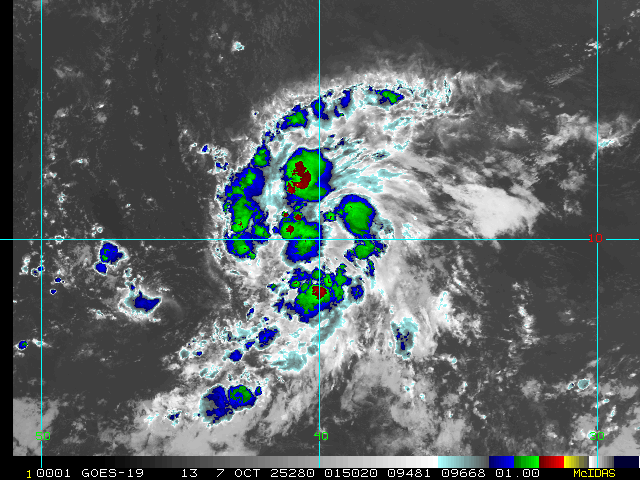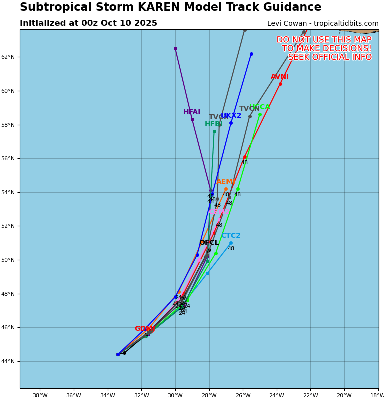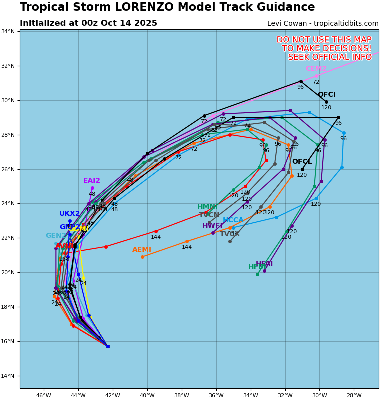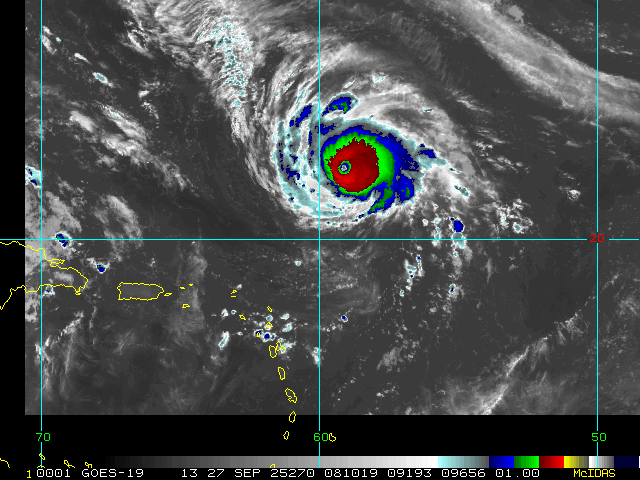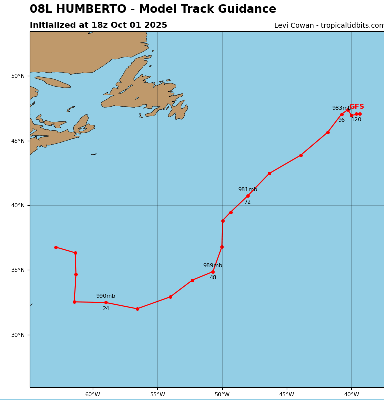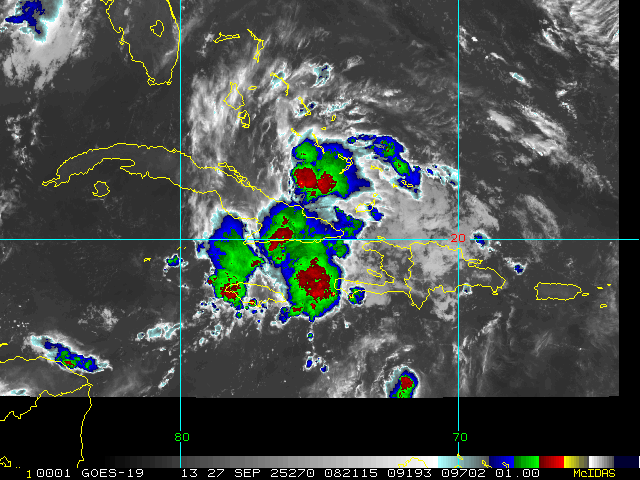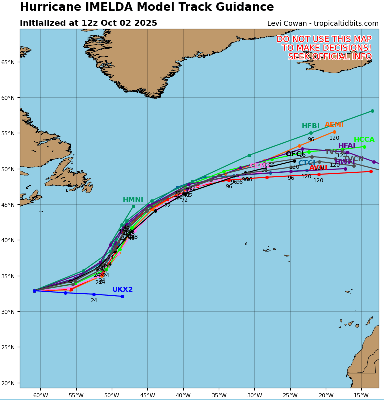Hurricane Melissa Approaches Jamaica
Posted: 05:13 PM 25 October 2025 | 8 Comments | Add Comment | Newest: 05:15 PM 28-Oct EDT
Melissa is exiting northwestern Jamaica, now no longer a high-end Major hurricane, but a hurricane that is growing in size. Some restrengthening is also forecast, and eastern Cuba and the southeastern and central Bahamas should be rushing their preps to protect life and property to completion.
Ciel
11:00AM EDT 28 October 2025 Update
Melissa has become one of planet earth's top strongest landfalls in all of recorded history, having continued to intensify into landfall.
Now conservatively 185 MPH, pressure down to 892mb.
NHC Update Text:
Quote:
...EXTREMELY DANGEROUS CATEGORY 5 MELISSA ABOUT TO MAKE LANDFALL IN JAMAICA...
...CATASTROPHIC WINDS, FLASH FLOODING, AND STORM SURGE OCCURRING ON THE ISLAND...
SUMMARY OF 1100 AM EDT...1500 UTC...INFORMATION
-----------------------------------------------
LOCATION...17.9N 77.9W
ABOUT 40 MI...60 KM SE OF NEGRIL JAMAICA
ABOUT 235 MI...380 KM SW OF GUANTANAMO CUBA
MAXIMUM SUSTAINED WINDS...185 MPH...295 KM/H
PRESENT MOVEMENT...NNE OR 25 DEGREES AT 9 MPH...15 KM/H
MINIMUM CENTRAL PRESSURE...892 MB...26.34 INCHES
WATCHES AND WARNINGS
--------------------
CHANGES WITH THIS ADVISORY:
The Government of Cuba has issued a Hurricane Warning for the province of Las Tunas and a Tropical Storm Warning for the province of Camaguey.
The Meteorological Service of the Bahamas has discontinued the Hurricane Watch for the Turks and Caicos islands.
SUMMARY OF WATCHES AND WARNINGS IN EFFECT:
A Hurricane Warning is in effect for...
* Jamaica
* Cuban provinces of Granma, Santiago de Cuba, Guantanamo, Holguin, and Las Tunas
* Southeastern and Central Bahamas
A Tropical Storm Warning is in effect for...
* Haiti
Ciel
11:00PM EDT 27 October 2025 Update
NHC Key Messages:
Quote:
1. Jamaica: Remain in your safe shelter. Catastrophic flash flooding and numerous landslides are expected through Tuesday. The eyewall’s destructive winds may cause total structural failure, particularly in higher elevations, leading to widespread infrastructural damage, prolonged power and communication outages, and isolated communities. Along the southern coast, life-threatening storm surge and damaging waves are anticipated through Tuesday. Failure to take immediate action may result in serious injury or significant loss of life.
2. Haiti and the Dominican Republic: Catastrophic flash flooding and landslides are expected across southwestern Haiti and southern portions of the Dominican Republic through midweek. In Haiti, extensive infrastructural damage and isolation of communities is likely. Tropical storm conditions are expected late Tuesday and Wednesday.
3. Eastern Cuba: Heavy rainfall with life-threatening flash flooding and landslides is expected to begin shortly. Life-threatening storm surge and damaging winds are expected late Tuesday and Tuesday night. Preparations should be rushed to completion.
4. Southeast and Central Bahamas and the Turks and Caicos: Hurricane conditions, life-threatening storm surge, and heavy rainfall are expected across portions of the southeast and central Bahamas on Wednesday. Residents should follow advice given by local officials and be sure to have preparations complete by Tuesday night. Tropical storm conditions, heavy rains, and a significant storm surge is expected in the Turks and Caicos Islands on Wednesday.
Ciel
10:00PM EDT 27 October 2025 Update
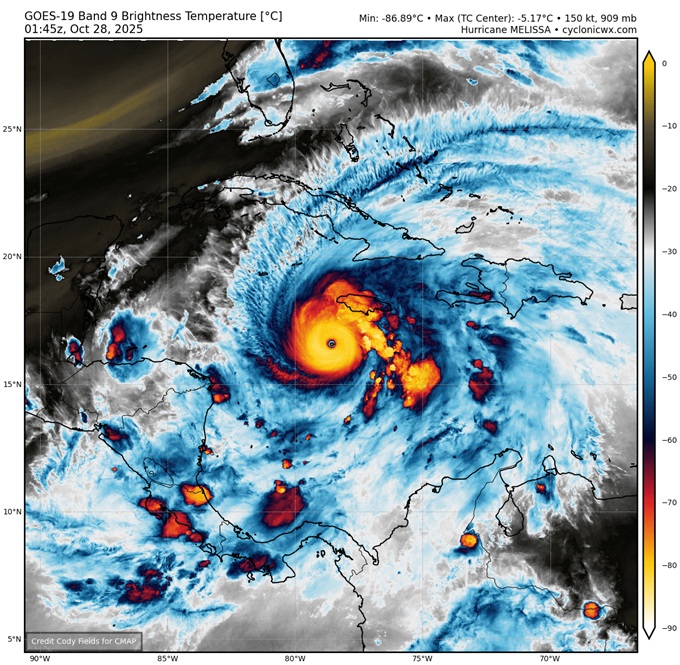
Melissa has resumed tracking north-northeast, but unlike a few days ago, this motion this time could also favor additional strengthening, however unbelievably so.
Melissa is now over some of the warmest, and deeply warmest, waters of the entire world, having tracked west of a (relatively) 'cooler' (less warm) eddy that is now to the cyclone's east. At the same time, the approaching trof that will ultimately sweep her up, is creating a very favorable outflow (exhaust) channel. It is not inconceivable that Melissa generally maintains or even intensifies further into landfall, save hard-to-foresee dynamics such as Eyewall Replacement Cycles. At a minimum, the hurricane appears to be strengthening further tonight.
Ciel
8:45PM EDT 27 October 2025 Update
Melissa continues tracking a touch west/west-southwest of forecast. Essentially, the more Melissa tracks w/sw/s, the more favorable environment for intensification the cyclone encounters. The stronger the cyclone gets, the more it feels the west-southwestward shove of the high pressure that is draped across to its north/northeast. Rinse. Repeat. While this is unlikely to continue forever, as a scouring trof is pushing off the CONUS that will most likely sweep Melissa up to the north-northeast, the hurricane is getting more time in even more favorable conditions, with a greater portion of Jamaica only now more likely to be in the typically worst Right Front Quadrant. Not ideal.
All this was discussed in our Melissa Forecast Lounge a few times. The Lounge is where we continue to do some deeper dives into modeling and more with Melissa.
Ciel
2:00PM EDT 27 October 2025 Update
Melissa is setting records. In fact, it appears that Melissa may now have the driest eye ever recorded on planet earth.
The 2PM NHC update pegs Melissa's maximum sustained winds at 175 MPH at the surface, but recon and satellite yet again support higher.
Recon recently measured winds at 1,000' above sea level of 240 MPH in the Right-Front-Quadrant (RFQ). Based on the current forecast track, locations on the mountainous island of Jamaica in the hurricane-force radii and within the RFQ may very well experience these winds, and several of these spots are well-populated.
Taking Mandeville as an example. According to Wikipedia, "Mandeville is the capital and largest town in the parish of Manchester in the county of Middlesex, Jamaica. In 2005, the town had an estimated population of 50,000, and including the immediate suburbs within a radius of 16 km the total population was about 72,000." Mandeville's elevation is roughly 2,000' above sea level.
11:00AM EDT 27 October 2025 Update
NHC goes with 165MPH as of the 11AM update today. This could be conservative. Recon data supports higher, and much higher at elevated locations a few hundred feet up, which are certain to impact portions of the island they cross with gusts well over 200 MPH.
On its current forecast track, Jamaican locations within about a 20 mile radius of the eye are likely to be laid in waste, unrecognizable and unlivable for weeks, possibly months, and in some places, potentially years. Flash flooding and land/mudslides will also do a number on areas even outside of the hurricane-force wind radii. Sheltering outside of locations known to be prone to flash flooding and landslides is recommended.
Ciel
5:30AM EDT 27 October 2025 Update
2025 just hit a massive milestone with Melissa becoming the third Category 5 of the year, putting 2025 only behind 2005 for numbers of Category Fives in any one season.
Recon has found pressures down to 917mb, still falling. Recon has also found winds arguably supportive of higher than the 5AM Advisory of 160MPH, still increasing. In fact, a dropsonde found the mean wind in the lowest 150 meters to be 180 MPH. Even a little higher speed than that was recorded at the proxy surface. Thus, the 5AM Adv #24 could be conservative.
It cannot be overstated how potentially dangerous Melissa is. Efforts to protect life and property should be rushed to completion in warned zones.
NHC
Quote:
...DESTRUCTIVE WINDS AND STORM SURGE AND CATASTROPHIC FLOODING WILL WORSEN ON JAMAICA THROUGH THE DAY AND INTO TONIGHT...
WATCHES AND WARNINGS
--------------------
CHANGES WITH THIS ADVISORY:
The government of the Bahamas has issued a Hurricane Watch for the central and southeastern Bahamas and the Turks and Caicos Islands.
SUMMARY OF WATCHES AND WARNINGS IN EFFECT:
A Hurricane Warning is in effect for...
* Jamaica
* Cuban provinces of Granma, Santiago de Cuba, Guantanamo, and Holguin.
A Hurricane Watch is in effect for...
* Southeastern and central Bahamas
* Turks and Caicos Islands
A Tropical Storm Warning is in effect for...
* Haiti
* Cuban province of Las Tunas
Ciel
12:30PM EDT 26 October 2025 Update
Melissa ended her southwesterly motion this morning and is now tracking generally west to west-northwest, possibly running headstrong into a little more shear, while also having ended her overnight DMAX cycle. These external and internal forces could be resulting in what is shown on radar out of Kingston, Jamaica, to be an open eyewall and some hints of the possible beginnings of an Eyewall Replacement Cycle (ER). Whatever the reasons, for the time being, Melissa has stopped intensifying, but remains an extremely powerful and dangerous Category Four MAJOR.
Melissa is not a hurricane to second guess in a year that, while so far very lucky for most in terms of landfalls, has still more or less kept up with the theme of the Atlantic basin since 1995. In fact, together with 2025's previous Majors (Gabrielle, Humberto and Erin), 2025 now ties with only 2005, 2008 and 2020 for the most 50+ knot RI events in a season (4): Gabrielle, Humberto, Erin and now Melissa. h/t Kieran Bhatia
SUMMARY OF WATCHES AND WARNINGS IN EFFECT AS OF THIS UPDATE:
A Hurricane Warning is in effect for
* Jamaica
A Hurricane Watch is in effect for
* Southwestern peninsula of Haiti from the border with the Dominican Republic to Port-Au-Prince
* Cuban provinces of Granma, Santiago de Cuba, Guantanamo, and Holguin.
A Tropical Storm Warning in effect for...
* Southwestern peninsula of Haiti from the border with the Dominican Republic to Port-Au-Prince
Ciel
Original Update
Melissa is now a hurricane and has a rare forecast calling for a Category 5 major hurricane before landfall, impacts will start to pick up tomorrow and increase in intensity rapidly Monday and landfall possibly early Tuesday morning in the pre-dawn areas somewhere in Jamaica.
If the forecast is correct, it will be the strongest hurricane to impact Jamaica since records began. ;
Active Jamaica Radar Loop:
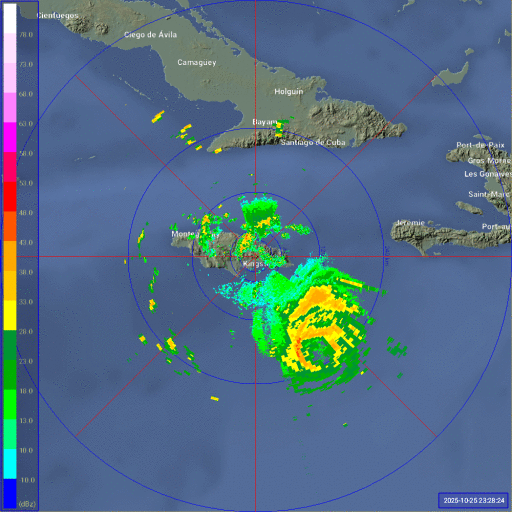
Melissa Event Related Links
Tropical Tidbits Page on system
Flhurricane Satellite Floater Animation of Melissa
GOES Floater
Tomer Berg Info page for Melissa
CyclonicWx Page for Melissa
Clark Evans Track Model Plot of Melissa
(Animated!) Model Plots in Google Earth - In Google Maps
Clark Evans Intensity Model Plot of Melissa (Animated!)
Clark Evans Track Plot of Melissa
Clark Evans Top 10 Analog Storms for Melissa
http://www.ral.ucar.edu/guidance/realtime/current/ More model runs on from RAL/Jonathan Vigh's page
NRL Info on Melissa -- RAMMB Info
COD Atlantic Satellite View
StormCarib Reports from the Caribbean Islands
Caribbean Weather Observations
Full Caribbean Radar Composite
Caribbean Broadcast Corporation (TV/Radio from Antilles)
Jamaica Storm Info/Media
Jamaican Meteorological Service
Jamaica Office of Disaster Preparedness & Emergency Management
Bermuda Newspapers/Media/Info:
Jamaica Live Cameras
Timelapses and more from Jamiaca
Jamaica Power Outage map
Melissa in the Caribbean
Posted: 01:18 PM 18 October 2025 | 5 Comments | Add Comment | Newest: 07:14 PM 24-Oct EDT
Melissa has a chance to intensify rapidly enough to track further west upon feeling the new steering currents, but would be doing so from a point now further east than forecast, due to center relocations earlier today. As a result, the 5PM Advisory now has Melissa, as a borderline Cat 5, tracking directly across Jamaica.
It is important to stress that even if a direct path across Jamaica does not occur, Melissa's increased size and slow forward speed will almost certainly result in profoundly catastrophic flash flooding and mudslides, regardless of the maximum wind speeds on land. Preparations to protect life and property from flooding and mudslides should be every bit as important as protecting from the wind.
NHC:
Quote:
Key Messages:
1. Jamaica: Due to Melissa’s slow motion, a prolonged multi-day period of damaging winds and heavy rainfall resulting in potentially catastrophic flash flooding and numerous landslides is likely to begin late Saturday or Sunday. There is an increasing risk of life-threatening storm surge when the center of Melissa nears Jamaica early next week. Preparations to protect life and property should be rushed to completion.
2. Haiti: Heavy rainfall will result in catastrophic flash flooding and landslides across southwestern Haiti into early next week. Extensive damage to roads and buildings is expected, potentially isolating communities for an extended period of time. Immediate preparations to protect life and property should be taken. Strong winds could also potentially last for a day or more over the Tiburon peninsula of Haiti.
3. Dominican Republic: Heavy rainfall could produce potentially catastrophic flash flooding and numerous landslides in southern portions of the Dominican Republic.
4. Eastern Cuba and Bahamas: Interests in Cuba and the Bahamas should monitor the progress of Melissa since there is an increasing risk of significant storm storm surge, damaging winds, and heavy rainfall by the middle of next week. The risk of life-threatening flash flooding and landslides in eastern Cuba are increasing.
Ciel
2:00AM EDT 24 October 2025 Update
The forecast for Melissa is one of the trickiest and least straight forward the NHC has had to do in quite some time. Even with multiple recon missions, so many competing forces and variables being at play have made certain details of lower confidence. However, what is not of low confidence, is that Melissa is not a tropical cyclone to roll the dice on. Taking a personal liberty here to ask our friends in and around Jamaica and Haiti to do everything possible to prepare for the worst and hope for the best. The potential for Melissa to become one of the most catastrophic hurricanes in the Atlantic basin so far this century can not be overstated.
Ciel
11:30PM EDT 23 October 2025 Update
Tropical Storm Melissa is forecast to make a multi-day major blow to Jamaica, with a fairly grim forecast that would impact the island with mulltiple days of extremely heavy rain, winds, and storm surge, across the entire island, and with most of the surge being on the south side of the island. (entire length of it) Those there please take it seriously.
the key messages states it best. Due to Melissa’s slow motion, the risk of a prolonged multi-day period of potentially damaging winds, heavy rainfall resulting in life-threatening flash flooding and numerous landslides, and storm surge continues to increase for Jamaica. Preparations to protect life and property should be rushed to completion, since strong winds and flooding rains could begin in Jamaica by Saturday.
Beyond this, eastern Cuba, including Guantanamo bay, and the Bahamas will need to watch, as well as eventually Bermuda.
2:30PM EDT 22 October 2025 Update
Melissa has once again proceeded west, which puts the center effectively a little southwest of where it was expected at this time, and would have to
shoot a touch northeast to realign, which is possible with a center jump, but until then, once again, Melissa is southwest of forecast.
Quote:
At 200 PM EDT (1800 UTC), the center of Tropical Storm Melissa was located by Air Force Reserve reconnaissance aircraft near latitude 14.3 North, longitude 74.0 West. Melissa is moving slowly toward the west near 2 mph (4 km/h). (NHC)
The chance for the quicker northeast across Hispaniola and out-to-sea track continues diminishing, with the risk of a meander in the central-western Caribbean and becoming a high-end Major hurricane, producing rounds and rounds of rainfall for affected nearby landmasses, increasing.
Ciel
11:00AM EDT 22 October 2025 Update
Melissa is now officially forecast to become a Major Hurricane, and very slow moving, in the central to western Caribbean. Interests in this region should begin considering taking necessary precautions to protect life and property, as this set up is particularly conducive to a high-end tropical cyclone that gets its name retired.
Ciel
10:30AM EDT 21 October 2025 Update
Invest 98L has become Tropical Storm Melissa
WATCHES AND WARNINGS
A Hurricane Watch has been issued for the southern peninsula of Haiti from the border with the Dominican Republic to Port-Au-Prince. The government of Jamaica has issued a Tropical Storm Watch for the island.
Ciel
2:30AM EDT 21 October 2025 Update
Advisories are expected to begin at any time today for either Potential Tropical Cyclone, or more likely still, Tropical Storm Melissa.
WARNINGS
...CARIBBEAN GALE WARNING...
Caribbean within 15N68W to 15N69W to 15N70W to 14N68W to 15N68W E to SE winds 30 to 35 KT. Seas 2.5 to 3.0 M.
The Meteorological Service of Jamaica has issued a Severe Weather Alert for the entire island, effective until 5 p.m. on Thursday.
Ciel
8:00PM EDT 20 October 2025 Update
NHC has increased their 2-day development probability that 98L becomes a TC to 90%. Watches and Warnings for locations in the Caribbean could be coming as soon as overnight tonight. Regardless of imminent Watches/Warnings, portions of the ABC Islands can expect heavy rain and strong wind gusts the next few days. Puerto Rico, Hispaniola, Jamaica and Cuba could be looking at even more significant impacts, including the possibility of extreme rainfall totals and very high winds by mid to late week.
The next name on the list this year is Melissa. There is a very real possibility that this system, should it become Melissa as is very likely, gets retired. Interests around the Caribbean should begin considering paying very close attention, monitoring reliable local advisories and forecasts, and keeping abreast of updates from the National Hurricane Center.
Ciel
1:45AM EDT 19 October 2025 Update
Invest 98L appears to be ramping up tonight.
During the last few frames of daylight satellite imagery, a little LLC could be seen, which could also now be getting nestled underneath persistent deep convection. Additionally, recent scatterometer data shows surface winds likely gusting well into tropical storm force in portions of its eastern side.
Interests in the Lesser Antilles may want to consider making some initial preps for what could be a very stout wave, or even perhaps, if the wave can close off prior to or during passage into the Caribbean, a bona fide tropical storm. TC genesis still looks much more possible once it is in the central to western Caribbean owing to its current fast forward speed, but the chance of development prior to reaching the Caribbean may be going up.
Ciel
Original Update
With occluding fronts rolling into the subtropics and tropical waves still rolling into the tropics, opportunities for development continue into the second half of this back-loaded 2025 Atlantic Hurricane Season. One silver lining, climatology increasingly disfavors mainland US landfalls from October on. However, this is not the case for locations in and around the Caribbean, nor for Bermuda, and systems are still deserving to be watched.
The most impressive wave of two we have been tracking for some time now has just been Invest tagged, 98L. The wave ahead of it also has a chance to develop, but appears to be less than 98's. Interests in and around the Caribbean may want to begin paying closer attention to both of these waves.
Model deep dives and speculation on 98L/Melisssa: Melissa Forecast Lounge
Melissa Event Related Links
Tropical Tidbits Page on system
Flhurricane Satellite Floater Animation of Melissa
GOES Floater
Tomer Berg Info page for Melissa
CyclonicWx Page for Melissa
Clark Evans Track Model Plot of Melissa
(Animated!) Model Plots in Google Earth - In Google Maps
Clark Evans Intensity Model Plot of Melissa (Animated!)
Clark Evans Track Plot of Melissa
Clark Evans Top 10 Analog Storms for Melissa
http://www.ral.ucar.edu/guidance/realtime/current/ More model runs on from RAL/Jonathan Vigh's page
NRL Info on Melissa -- RAMMB Info
COD Atlantic Satellite View
StormCarib Reports from the Caribbean Islands
Caribbean Weather Observations
Full Caribbean Radar Composite
Caribbean Broadcast Corporation (TV/Radio from Antilles)
Jamaica Storm Info/Media
Jamaican Meteorological Service
Jamaica Office of Disaster Preparedness & Emergency Management
Jamaica Live Cameras
Timelapses and more from Jamiaca
Jamaica Power Outage map
Invest 96L in the far northern Atlantic has become Subtropical Storm Karen. Karen is very much a fish spinner, presently near 44.5N 33W, also unlikely to add much at all to seasonal ACE, but does qualify as a legitimate name in this back-loaded 2025.
Ciel
10:45AM EDT 9 October 2025 Update
Jerry has been a little weaker and less organized that forecast, which may help explain why the storm continues to track southwest of consensus and the official line. But that is not to say that Jerry is weak. Tropical Storm conditions on portions of the Leeward Islands is becoming increasingly likely. The government of Antigua and Barbuda has issued a Tropical Storm Warning for Barbuda.
Ciel
10:50PM EDT 7 October 2025 Update
Tropical Storm Jerry has formed from a wave we have been tracking for some time, and is now officially forecast to brush the northern Leeward Islands. While confidence in a "recurve" out to sea is fairly strong, just when that turn happens and by how much of an angle is less so, and even a little deviation to the south of the NHC cone may bring strong tropical storm or even hurricane conditions to these islands, or at least just off their coasts.
Tropical Storm Watches are up for much of this area, and the USVI and Puerto Rico also should monitor.
NHC:
Quote:
SUMMARY OF WATCHES AND WARNINGS IN EFFECT:
A Tropical Storm Watch is in effect for...
* Antigua, Barbuda, and Anguilla
* St. Kitts, Nevis, and Montserrat
* St. Barthelemy and St. Martin
* Sint Maarten
* Saba and St. Eustatius
* Guadeloupe and the adjacent islands
Interests elsewhere in the northern Leeward Islands, and the British and U.S. Virgin Islands should monitor the progress of Jerry.
Elsewhere, a very low risk NHC 10% lemon outline exists over the Bay of Campeche for the next 48 hours or so, probably a blustery rain-maker in northeastern Mexico, and in the eastern Pacific, remnant moisture and energy from Hurricane Priscilla will likely bring scattered to numerous showers and thunderstorms to the southwestern US later this week into early next week, and last but not least, off the southeast coast, a non-tropical low could become a powerful Nor'easter of the liquid variety over the weekend.
Ciel
Original Update
The month of October has kicked off with a few weak lows in the Gulf and east of Florida that struggled and faded away due to high shear. So far, the CONUS has remained protected for most of this year, fortunately.
Out in the eastern Atlantic, we are watching what is now Invest 95L. This disturbance is widely expected by models to become our next named storm and could be something for the Antilles to keep an eye on late next week. A Forecast Lounge is available for this feature: 95L Forecast Lounge
Jerry Event Related Links
Tropical Tidbits Page on system
Flhurricane Satellite Floater Animation of Jerry
GOES Floater
Tomer Berg Info page for Jerry
CyclonicWx Page for Jerry
Clark Evans Track Model Plot of Jerry
(Animated!) Model Plots in Google Earth - In Google Maps
Clark Evans Intensity Model Plot of Jerry (Animated!)
Clark Evans Track Plot of Jerry
Clark Evans Top 10 Analog Storms for Jerry
http://www.ral.ucar.edu/guidance/realtime/current/ More model runs on from RAL/Jonathan Vigh's page
NRL Info on Jerry -- RAMMB Info
COD Atlantic Satellite View
Karen Event Related Links
Tropical Tidbits Page on system
Flhurricane Satellite Floater Animation of Karen
GOES Floater
Tomer Berg Info page for Karen
CyclonicWx Page for Karen
Clark Evans Track Model Plot of Karen
(Animated!) Model Plots in Google Earth - In Google Maps
Clark Evans Intensity Model Plot of Karen (Animated!)
Clark Evans Track Plot of Karen
Clark Evans Top 10 Analog Storms for Karen
http://www.ral.ucar.edu/guidance/realtime/current/ More model runs on from RAL/Jonathan Vigh's page
NRL Info on Karen -- RAMMB Info
COD Atlantic Satellite View
Invest 97L Event Related Links
Tropical Tidbits Page on system
Flhurricane Satellite Floater Animation of 97
GOES Floater
Tomer Berg Info page for 97
CyclonicWx Page for 97
Clark Evans Track Model Plot of 97
(Animated!) Model Plots in Google Earth - In Google Maps
Clark Evans Intensity Model Plot of 97 (Animated!)
Clark Evans Top 10 Analog Storms for 97
http://www.ral.ucar.edu/guidance/realtime/current/ More model runs on from RAL/Jonathan Vigh's page
NRL Info on 97 -- RAMMB Info
COD Atlantic Satellite View
StormCarib Reports from the Caribbean Islands
Caribbean Weather Observations
Full Caribbean Radar Composite
Caribbean Broadcast Corporation (TV/Radio from Antilles)
Humberto and Imelda
Posted: 11:43 AM 26 September 2025 | 2 Comments | Add Comment | Newest: 08:49 AM 30-Sep EDT
Overnight, Imelda continued to organize deep convection despite nearby dry air and occasional dry air intrusions, and has become a stout Cat 1 hurricane. Further strengthening is probable and forecast, although not assured. There is a fair chance of significant strengthening now that Imelda is better organized and could fight off shear and dry air for a while as it tracks towards Bermuda, which all guidance has in its sights between 36-48 or so hours from now. The Hurricane Watch for Bermuda could soon become a Hurricane Warning.
Ciel
5AM EDT 28 September 2025 Update
More northerly motion has begun on TD#9 and the models have finally reached a decent consensus, which matches the current forecast track. T#9 is forecast to stay east of Florida (some areas along the east coast may see some squally weather) and make a hard right turn out to sea probably around Daytona and follow Humberto out to sea. Bermuda should watch, but the risk to the southeast ts rapidly decreasing.
11AM EDT 27 September 2025 Update
Tropical Depression Nine has formed.
A Tropical Storm Watch has been issued for the east coast of Florida from the Palm Beach/Martin County Line northward to the Flagler/Volusia County Line.
from discussion:
Given the risk of tropical-storm-force winds along the east coast of
Florida, a Tropical Storm Watch has been issued from the Palm
Beach/Martin County Line northward to the Flagler/Volusia County
Line. Although it is still too early to specify the details of
potential impacts along the remainder of the southeast U.S. coast,
there remains a risk of heavy rainfall, storm surge, and wind
impacts.
10AM EDT 27 September 2025 Update
Humberto is now a powerful category 4 hurricane and is forecast to become a 5, the cone takes it north of Bermuda, but those there should monitor it closely.
For PTC9 it may develop later today, and the official forecast stall sit offshore of South Carolina. Tropical Storm Warnings are up for most of the Bahamas this weekend as it will pass through there. Dryer air in the Gulf will likely keep most of the convection and rain away from Florida as it passes by, as the storm doesn't have much on the west side, most areas in Florida won't see any rain from it. Beyond the Bahamas it's currently expected to stall offshore, but possibly close enough to South Carolina for some impacts there, and then head generally out to sea. There's is still a high degree of uncertainty, but that is currently the most likely. Everyone along the southeast and Bermuda should monitor this system, as things could change, especially if the system forms north of forecast or moves faster than forecast since it has not developed yet.
6:40PM EDT 26 September 2025 Update
Advisory packages are now out on NINE (Potential Tropical Cyclone formerly tracked as Invest 94L)
Quote:
Potential Tropical Cyclone Nine Advisory Number 1
NWS National Hurricane Center Miami FL AL092025
500 PM EDT Fri Sep 26 2025
...TROPICAL STORM WATCHES AND WARNINGS ISSUED FOR PORTIONS OF THE BAHAMAS...
WATCHES AND WARNINGS
--------------------
CHANGES WITH THIS ADVISORY:
The government of the Bahamas has issued a Tropical Storm Warning for the central Bahamas and a Tropical Storm Watch for portions of thenorthwestern Bahamas.
SUMMARY OF WATCHES AND WARNINGS IN EFFECT:
A Tropical Storm Warning is in effect for...
* Central Bahamas, including Cat Island, the Exumas, Long Island, Rum Cay, and San Salvador.
A Tropical Storm Watch is in effect for...
* Portions of the northwestern Bahamas, including Eleuthera, New Providence, the Abacos, Berry Islands, and Grand Bahama Island.
Ciel
Original Update
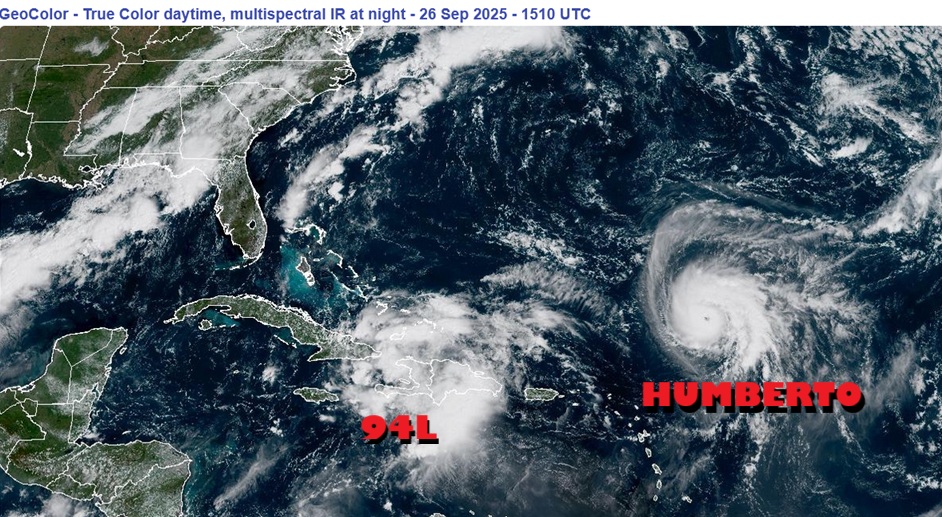
With echos of 2024, after a confounding long duration pause during the "peak" of the season that lulled many into complacency, the Atlantic basin is off to the races as we close out the month of September.
Hurricane Humberto is on the fast track to become a Major, our third of the year, and could accomplish this as soon as this afternoon. The updated NHC track has Bermuda in the Cone as well as potentially the Right Front Quadrant, where more often than not, the strongest weather occurs (wind, rain, flooding, surge, waterspouts, etc). There is a reasonable chance that Humberto reaches mid/high-end Saffir-Simpson Cat 4, and in fact, Cat 5 is not at all out of the question. In addition, Humberto has been growing larger, so impacts will likely be felt on the island regardless of whether or not there is a direct strike.
Invest 94L continues organizing and NHC Advisories could be coming out at any time whether or not a TC has yet formed, as tropical storm/hurricane conditions and storm surge could be coming to the Bahamas and Southeast US within 72 hours. While the ramp for Rapid Intensification does not look as easy for 94L as it appears to be for Humberto, 94L could also become a powerful hurricane. In addition, a PRE (Predecessor Rain Event) is setting up in states along the southeast and portions of the mid-Atlantic. Between the PRE and likely-Imelda-to-be, flooding may become widespread and potentially locally catastrophic. Interests in states such as Georgia, the Carolinas and Virginia may want to begin paying very close attention to official forecasts and warnings for 94L/Imelda, and take all prudent precautions.
Model deep dives and speculations in the Forecast Lounge:
Humberto Forecast Lounge
Imelda Forecast Lounge
Humberto Event Related Links
Tropical Tidbits Page on system
Flhurricane Satellite Floater Animation of Humberto
GOES Floater
Tomer Berg Info page for Humberto
CyclonicWx Page for Humberto
Clark Evans Track Model Plot of Humberto
(Animated!) Model Plots in Google Earth - In Google Maps
Clark Evans Intensity Model Plot of Humberto (Animated!)
Clark Evans Track Plot of Humberto
Clark Evans Top 10 Analog Storms for Humberto
http://www.ral.ucar.edu/guidance/realtime/current/ More model runs on from RAL/Jonathan Vigh's page
NRL Info on Humberto -- RAMMB Info
COD Atlantic Satellite View
Imelda Event Related Links
Tropical Tidbits Page on system
Flhurricane Satellite Floater Animation of Imelda
GOES Floater
Tomer Berg Info page for Imelda
CyclonicWx Page for Imelda
Clark Evans Track Model Plot of Imelda
(Animated!) Model Plots in Google Earth - In Google Maps
Clark Evans Intensity Model Plot of Imelda (Animated!)
Clark Evans Track Plot of Imelda
Clark Evans Top 10 Analog Storms for Imelda
http://www.ral.ucar.edu/guidance/realtime/current/ More model runs on from RAL/Jonathan Vigh's page
NRL Info on Imelda -- RAMMB Info
COD Atlantic Satellite View
Bermuda Newspapers/Media/Info:
Humberto is now a hurricane this morning and Bermuda is in the cone, however it is likely to stay west of Bermuda, although those there should keep an eye on it.
Invest 94L still has a 80/90% chance to develop, high level steering recon is out en force today, but the first low level standard one happens this afternoon. Advisories may start at any time today on this system. There still is quite a bit of uncertainty in regards to the track and intensity of 94L going forward because of how close Humberto is, but those along the southeast, particularly in South Carolina and North Carolina need to pay close attention.
12:30PM EDT 25 September 2025 Update
It is increasingly likely that NHC Advisories will begin on what should ultimately become Imelda, whether or not a TC has yet formed. This is because models are now strongly advertising development with impacts on land (Bahamas, specifically) within the next 72 hours. In fact, tropical storm conditions could arrive within just the next 48 hours. Interests in the Bahamas may already want to be making initial preparations for the arrival of tropical cyclone conditions over the weekend that could continue into early next week.
Updated Issuance Criteria for Potential Tropical Cyclone Advisory
Quote:
The National Hurricane Center (NHC), the Central Pacific Hurricane Center (CPHC), and the National Weather Service (NWS) have updated the issuance criteria for tropical cyclone advisory products for Potential Tropical Cyclones. A Potential Tropical Cyclone (PTC) is a disturbance that is not yet a tropical cyclone but poses the threat of bringing tropical storm or hurricane conditions to land areas. With the change, the NHC and CPHC will have the ability to issue tropical cyclone advisory products up to 72 hours before the anticipated arrival of storm surge or tropical-storm-force winds on land regardless of the immediate need for land-based tropical storm, hurricane, or storm surge watches or warnings. Previously, NHC and CPHC could only begin issuing advisory products for PTCs that required land-based watches (issued 48 hours in advance of conditions beginning) or warnings (issued 36 hours in advance of conditions beginning). This change gives NHC and CPHC the option to issue these advisory products at longer lead times when confidence is high that there is a significant risk of wind and storm surge impacts to land areas. Tropical cyclone advisory products for PTCs include all storm-specific text and graphical products routinely issued by NHC and CPHC each advisory cycle (i.e., 0300, 0900, 1500, and 2100 Coordinated Universal Time (UTC)), such as the Tropical Cyclone Public Advisory (TCP) and the Cone Graphic.
Ciel
8:00AM EDT 25 September 2025 Update
Invest 93L became Tropical Storm Humberto yesterday and is now officially forecast to become a Major by Monday. Interests in Bermuda may want to watch it closely, as while presently outside of the cone, NHC track error margins this far out can be significant.
Invest 94L now has NHC 90% chances of developing this week and 70% within just the next 48 hours. Models strongly suggest that the US could be in play. This disturbance bears very close watching for everyone from the Bahamas up through Florida and the entire southeast. Advisories could be coming soon even if a depression has not yet formed. Recon is aggressively flying and sampling the environment in and around 94L, and this invaluable data will help improve the forecasts going forward.
Way out in the northeastern subtropical Atlantic, a wind max associated with Hurricane Gabrielle could really do a number on the Azores overnight tonight into Friday, and interests there should be rushing preparations to completion for a very strong Cat 1 hurricane that could come in causing more damage than that of a typical Cat 1.
The concerns about a potentially active back half of the season are verifying.
Ciel
9:30PM EDT 23 September 2025 Update

Conditions for development of both Invests 93L and 94L continue improving, and given their close proximity to land and the updated 2025 NHC policy allowing advisories to be issued on Potential Tropical Cyclones, "PTCs," up to 72 hours before the anticipated arrival of storm surge or tropical-storm-force winds on land whether or not a bona fide TC has yet formed, official NHC advisories, possibly even watches and/or warnings, could be coming within the next 24 hours, even as quickly as by tomorrow morning.
Forecasting the tracks and intensities of both Invest 93L and 94L is very challenging, even for the best computer models and most seasoned hurricane experts. More competing and interacting influences than normal, not the least of which could be their proximity to one another, will likely result in any initial forecasts and advisories being of lower confidence than usual.
More than a half dozen recon flights have already been scheduled for 94L, which is the disturbance closest to land. Flights will almost certainly get added soon for 93L, as well.
Ciel
12:00PM EDT 23 September 2025 Update
A Hurricane Watch is now in place for all of the Azores in the northeastern Subtropical Atlantic with Gabrielle. Strong Cat 1/2 hurricane conditions are increasingly likely across the islands late Thursday into early Friday. Interests in the Azores islands should begin taking hurricane preparations as conditions are forecast to deteriorate rapidly within the next 48 hours.
Soon after passing through the Azores, strong post-tropical/hybrid storm conditions are increasingly possible in Spain and Portugal over the coming weekend into Monday with damaging winds and heavy surf.
Much closer to home, model runs continue heating up on newly Invest-tagged 93L and 94L, with a few notable exceptions. Conditions for development in the Atlantic basin are orders of magnitude improved over just a few weeks ago and it would not be surprising to see both get named. The next names on the list in the Atlantic this year are Humberto and Imelda.
Deeper model dives and speculation on all three of these can be found in the Forecast Lounge Forum:
Invest 93L Forecast Lounge
Invest 94L Forecast Lounge
Hurricane Gabrielle Forecast Lounge
Quote:
The Azores Meteorological Service has issued a Hurricane Watch for all the islands of the Azores.
SUMMARY OF WATCHES AND WARNINGS IN EFFECT:
A Hurricane Watch is in effect for ... All of the Azores
Ciel
1:00PM EDT 22 September 2025 Update
Gabrielle became our second Major of the year while comfortably southeast of Bermuda.
Recon missions are presently sampling the very well-developed hurricane and finding that an eyewall replacement cycle could be starting, but for now, weakening has not commenced. Once the ERC has completed, it is possible that the hurricane's windfield is larger, with its upper-bound on the Saffir-Simpson scale a bit restricted as a trade-off. Given the potential for a larger Gabrielle, interests in the Azores may want to begin paying more attention, as hurricane conditions there could occur in less than 72 hours.
Elsewhere, three other areas of interest are on our radar. More on these to come.
Ciel
10:00AM EDT 17 September 2025 Update
Invest 92L became designated TD 7 early this morning. SEVEN is a very sloppy depression, and there may even be an argument that it remains more of a trof than one would like to see in a designated TC.
Initial runs on 92L pegged the disturbance around 13N, with NHC initial positioning of SEVEN at 13.7N. The system tracked as SEVEN now appears to be closer to 19N, based on conventional satellite imagery. Models and forecasts of SEVEN should be taken with a large helping of salt until there is more clarity. "TD 7" could have made a jump into the northern portion of the trof axis.
More on this in the Gabrielle Lounge
Ciel
Original Update
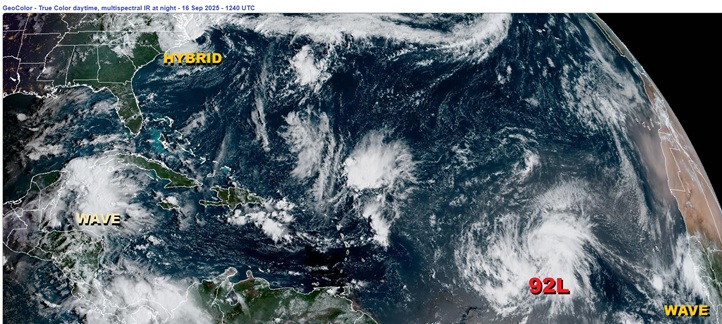
After a peak-season hibernation the likes of which have not been seen since 1939, the Atlantic basin is waking back up.
Basin-wide conditions for development are improving this week. A positive pulse from the MJO along with a climatologically consistent trend towards greater instability overall as we head into fall will conspire to enhance thunderstorm activity. Higher pressure in the subtropics appears set to weaken and/or shove away some of the TUTTs that have imparted high levels of shear and dry air over the past month. Meanwhile, the waves keep rolling off of Africa.
One of the waves to recently exit Africa is now on the cusp of becoming our next TD. This disturbance, Invest 92L, has potential to become a long-track Cape Verde-type storm, provided the basin does perform this week as forecast. Several models give 92L decent odds to become a powerful hurricane. Fortunately, very few models take it towards land, but at a minimum, Bermuda should watch.
Behind 92L another wave appears to have a good shot at development. This one is not yet Invest tagged.
Closer to home, a hybrid coastal storm off the coast of NC/VA remains too attached to its parent fronts and is under too much shear to have much more than maybe a 2% chance at a name, but those right along the coasts in this region probably agree that it "feels" like something with a name. This is expected to weaken today and track out to sea.
Gabrielle Event Related Links
Tropical Tidbits Page on system
Flhurricane Satellite Floater Animation of Gabrielle
GOES Floater
Tomer Berg Info page for Gabrielle
CyclonicWx Page for Gabrielle
Clark Evans Track Model Plot of Gabrielle
(Animated!) Model Plots in Google Earth - In Google Maps
Clark Evans Intensity Model Plot of Gabrielle (Animated!)
Clark Evans Track Plot of Gabrielle
Clark Evans Top 10 Analog Storms for Gabrielle
http://www.ral.ucar.edu/guidance/realtime/current/ More model runs on from RAL/Jonathan Vigh's page
NRL Info on Gabrielle -- RAMMB Info
COD Atlantic Satellite View
Humberto Event Related Links
Tropical Tidbits Page on system
Flhurricane Satellite Floater Animation of Humberto
GOES Floater
Tomer Berg Info page for Humberto
CyclonicWx Page for Humberto
Clark Evans Track Model Plot of Humberto
(Animated!) Model Plots in Google Earth - In Google Maps
Clark Evans Intensity Model Plot of Humberto (Animated!)
Clark Evans Track Plot of Humberto
Clark Evans Top 10 Analog Storms for Humberto
http://www.ral.ucar.edu/guidance/realtime/current/ More model runs on from RAL/Jonathan Vigh's page
NRL Info on Humberto -- RAMMB Info
COD Atlantic Satellite View
Invest 94L Event Related Links
Tropical Tidbits Page on system
Flhurricane Satellite Floater Animation of 94L
GOES Floater
Tomer Berg Info page for 94L
CyclonicWx Page for 94L
Clark Evans Track Model Plot of 94L
(Animated!) Model Plots in Google Earth - In Google Maps
Clark Evans Intensity Model Plot of 94L (Animated!)
Clark Evans Top 10 Analog Storms for 94L
http://www.ral.ucar.edu/guidance/realtime/current/ More model runs on from RAL/Jonathan Vigh's page
NRL Info on 94L -- RAMMB Info
COD Atlantic Satellite View
Coastal South Carolina Media:
94.3 WSC Charleston News Radio
Power Outage Map: South Carolina Power Outage Map
Bermuda Newspapers/Media/Info:
Ed Dunham
Hurricane Matthew Weather Summary for East Central Florida
Posted: 05:32 PM 16 October 2016
A low pressure reading of 28.97" was recorded at Melbourne NWS at 7AM. At 7:30AM I noted a pressure reading of 28.98" at my home in northwest Melbourne. The lowest pressure was located in the southern section of the eye of the hurricane and the central pressure from the Hurricane Hunters was recorded at 938MB (27.90") at 1AM. At 4AM the aircraft reported a circular eye with a diameter of 32NM and a central pressure of 942MB with flight level wind at 118 knots which translates to a 100 knot surface wind (115mph). At 7:17AM the aircraft sent a position fix for the eye at 28.6N 80.2W with a pressure of 942MB and eyewall sustained surface winds of 110 knots. The eye of Matthew had contracted to a circular 20NM diameter as the hurricane passed to the east of the area. Although the radius of the eye had contracted from 17NM to 10NM, the radius of sustained hurricane force winds remained at 40 miles to the west of the center. The central pressure increased and leveled off at 947MB during the day on Friday as Matthew moved NNW. If the eye of Matthew had moved along the shoreline, i.e., if it had been 35-40 miles further to the west, damage would have certainly been greater but no realistic conclusion can be made with regard to the extent of the destruction because an on-shore system would have slowly weakened.
Matthew goes into the record books as a Category I Hurricane in a small section of the Brevard County coast. In some reports from the NHC the flight level Recon wind speeds were not reduced correctly and resulted in stated maximum eyewall surface wind speeds that were about 10mph too high - and I cannot find a valid meteorological reason for doing this. Hurricane Erin in 1995 and Hurricanes Frances and Jeanne in 2004 were all storms with a greater impact on Brevard County. While the early call by the Brevard Emergency Management Operations Center to evacuate residents from the Barrier Islands was prudent, the overstated intensity and inland impacts were mis-leading and confusing to some of our residents. The National Hurricane Center and The Weather Channel both over-hyped the overall magnitude of the storm - which will not help folks to make the correct decision when the next hurricane visits our area. Matthew was not the catastrophic Category IV storm of the century that was touted by some for our area. All hurricanes are dangerous and deserve proper preparation and decision-making. It is worth noting that the area from Melbourne Beach to Titusville has never recorded a Cat III or greater hurricane. Someday that record of 165 years will probably be broken, but Matthew was not that storm. Hurricane David, September 3-4, 1979, was the last Category II Hurricane to hit this area with eye passage along the coast from West Palm Beach to New Smyrna Beach.
ED
Selected Weather Reports:
Vero Beach - wind W 49G74mph Rainfall 3.16"
Sebastian - wind N 30G59mph
5N Barefoot Bay - wind N G74mph
4NNW Grant - wind NW 51G68mph
Malabar - wind N 60G72mph
Melbourne Beach - wind N 23G63mph Lowest SLP: 28.85"
Melbourne (Dairy Road) - wind N 44G71mph
Melbourne - wind N 44G76mph Lowest SLP: 28.97"
NW Melbourne - wind NNW 42G65 Lowest SLP: 28.98 Storm Total Rainfall: 3.43"
Satellite Beach - wind N 69G87mph
2SSE Patrick AFB - wind N 69G88mph
South Patrick Shores - wind N 73G90mph Lowest SLP: 28.86"
Cocoa Beach Park - wind N 60G77mph
Merritt Island (Sunset Lakes) - wind NW 36G55mph Lowest SLP: 28.90"
Merritt Island (Banana River) - wind NNW 63G81mph
3WNW Cape Canaveral - wind gust N 86mph
4NE Cape Canaveral - wind gust NNW 81mph Coastal Flooding
5NE Port Canaveral - wind gust N 100mph
KSC Tower 22 - wind gust NW 107mph (non-standard anemometer height)
KSC Tower 3 - NNW 77G107mph (non-standard anemometer height)
Titusville (Parrish Park) - wind N 58G75mph
5NNE New Smyrna Beach - wind gust N 80mph
Daytona Beach (Speedway) - wind gust NNW 91mph
5NE Lake Mary - 24 hour rainfall 7.04"
Orlando Intl Airport - wind W 30G61mph Lowest SLP: 29.30"
From the Melbourne NWS:
G. STORM IMPACTS BY COUNTY...
---------------------------------------------------------------------
COUNTY DEATHS INJURIES EVACUATIONS
DESCRIPTION
---------------------------------------------------------------------
BREVARD 0 1 UNKNOWN
ONE DIRECT INJURY. A MALE IN HIS 40S WAS INJURED IN PORT CANAVERAL
WHEN A SIGN FELL AND STRUCK HIM DURING THE STORM. DAMAGE TO
BUSINESSES AND HOMES MAINLY AS A RESULT OF FALLEN TREES. SEVERAL
HOMES WITH WATER INTRUSION DUE TO DAMAGED ROOFS. TWO HOMES LOST TO
FIRE AS OFFICIALS SUSPENDED EMERGENCY SERVICES DURING THE HEIGHT OF
THE STORM. SPORADIC COUNTYWIDE DAMAGE TO FENCES...AWNINGS...AND
SCREEN ROOMS. AN INITIAL COASTAL SURVEY INDICATES MODERATE TO MAJOR
BEACH EROSION WITH SIGNIFICANT DAMAGE TO BERMS AND DUNES.
PRELIMINARY DAMAGE ASSESSMENT INDICATES AN ECONOMIC LOSS OF $25
MILLION DUE TO COASTAL EROSION, AND $4 MILLION DUE TO VEGETATIVE
LOSSES. PROPERTY DAMAGE ASSESSMENT HAS NOT BEEN COMPLETED. ABOUT
300,000 CUSTOMERS WERE WITHOUT POWER AT THE HEIGHT OF THE STORM.
INDIAN RIVER 0 0 UNKNOWN
NO DEATHS OR INJURIES. ROUGH SURF AND MAJOR BEACH EROSION.
PRELIMINARY BEACH DAMAGE ASSESSMENT DETAILS MAJOR DUNE EROSION AND
SIGNIFICANT DAMAGE TO PEDESTRIAN CROSSWALKS WITHIN COUNTY OWNED
BEACH PARKS WITH AN ESTIMATED ECONOMIC LOSS OF $13 MILLION. SEVERAL
HOMES DAMAGED MAINLY BY FALLEN TREES.
LAKE 0 0 UNKNOWN
NO DEATHS OR INJURIES. MINOR URBAN...ROADWAY...AND LOWLAND FLOODING.
THE ST. JOHNS RIVER NEAR ASTOR PEAKED JUST BELOW MODERATE FLOOD
STAGE. MINOR DAMAGE TO FOUR HOMES WITH MAJOR DAMAGE TO THREE CAUSED
MAINLY BY FALLING BRANCHES AND TREES. EARLY PROPERTY DAMAGE
ASSESSMENT OF APPROXIMATELY $389 THOUSAND.
MARTIN 0 1 UNKNOWN
ONE INDIRECT INJURY. A 47-YEAR-OLD MALE WAS ELECTROCUTED WHEN HIS
TOOLS HIT A LIVE POWER LINE WHILE TRIMMING TREES IN STUART AFTER
THE STORM ON MONDAY OCTOBER 10 AROUND 8:15 AM. ROUGH SURF AND MINOR
BEACH EROSION. MINOR DAMAGE TO HOMES MAINLY AS A RESULT OF FALLEN
TREES. ISOLATED DAMAGE TO FENCES...AWNINGS...AND SCREEN ROOMS.
PROPERTY DAMAGE ASSESSMENT NOT YET AVAILABLE.
OKEECHOBEE 0 0 UNKNOWN
NO DEATHS OR INJURIES. MINOR ROOF DAMAGE TO ONE HOME. UP TO 2300
CUSTOMERS WITHOUT POWER AT HEIGHT OF STORM.
ORANGE 1 0 UNKNOWN
ONE DEATH INDIRECTLY RELATED TO HURRICANE MATTHEW. A 70-YEAR-OLD
WOMAN DIED AFTER HER MEDICAL DEVICE FAILED DURING A POWER OUTAGE.
PROPERTY DAMAGE ASSESSMENT NOT YET AVAILABLE FROM OFFICIALS.
OSCEOLA 0 0 UNKNOWN
NO DEATHS OR INJURIES. NO REPORTS OF STRUCTURAL DAMAGE OR FLOODING.
MINOR DAMAGE MAINLY TO TREES AND VEGETATION. UP TO 5900 CUSTOMERS
WERE WITHOUT POWER AT THE HEIGHT OF THE STORM.
SEMINOLE 0 0 UNKNOWN
NO DEATHS OR INJURIES. MINOR URBAN...ROADWAY...LOWLAND AND RIVER
FLOODING. DAMAGE TO BUSINESSES AND RESIDENCES MAINLY BY FALLING
BRANCHES AND TREES. INITIAL PROPERTY DAMAGE ESTIMATED $15 MILLION.
UP TO 70,000 CUSTOMERS WITHOUT POWER AT THE HEIGHT OF THE STORM.
ST. LUCIE 2 2 UNKNOWN
TWO INDIRECT DEATHS AND TWO INDIRECT INJURIES. A 58-YEAR-OLD INDIAN
RIVER ESTATES WOMAN DIED OF A HEART ATTACK AND A PORT ST. LUCIE MAN
IN HIS 80S DIED AFTER SUFFERING BREATHING PROBLEMS AND SYMPTOMS OF A
STROKE AS FIRE OFFICIALS SUSPENDED EMERGENCY SERVICES DURING THE
HURRICANE. A 90-YEAR-OLD MALE AND FEMALE WERE FOUND UNCONSCIOUS IN
THEIR PORT ST. LUCIE HOME AFTER OFFICIALS DISCOVERED THEY WERE
RUNNING A GAS GENERATOR IN THEIR GARAGE. ROUGH SURF AND MODERATE TO
MAJOR BEACH EROSION. DAMAGE CONFINED MAINLY TO TREES...POWER
LINES...AND SIGNAGE THROUGH THE COUNTY. PROPERTY DAMAGE ASSESSMENT
NOT YET AVAIALBLE FROM OFFICIALS.
VOLUSIA 4 0 UNKNOWN
ONE DIRECT AND THREE INDIRECT FATALITIES. A 63-YEAR-OLD WOMAN DIED
WHEN A TREE FELL ON HER AS SHE WAS OUT FEEDING ANIMALS AT HER DELAND
HOME. A 89-YEAR-OLD MAN FROM DELEON SPRINGS WAS ELECTROCUTED BY A
DOWNED POWER LINE MONDAY MORNING AROUND 8:00 AM OCTOBER 10. A 47-
YEAR-OLD NORTHEAST OHIO MAN ASSISTING CLEANUP EFFORTS IN ORMOND
BEACH WAS KILLED WHEN PART OF A DOWNED TREE ROLLED ON TOP OF HIM AND
PINNED HIM UNDERNEATH. A 9-YEAR-OLD DAYTONA BEACH BOY WAS FOUND
UNCONSCIOUS IN HIS HOME AFTER OFFICIALS DISCOVERED A GENERATOR
RUNNING IN ANOTHER ROOM. THE BOY LATER DIED AT HALIFAX HEATLH
MEDICAL CENTER. SIGNIFICANT DAMAGE TO HOMES AND BUSINESS THROUGHOUT
THE COUNTY WITH OVER 6400 PROPERTIES AFFECTED, 1100 WITH MINOR
DAMAGE, 300 WITH MAJOR DAMAGE, AND 40 STRUCTURES DESTROYED. INITIAL
PROPERTY DAMAGE ESTIMATE OF $490 MILLION. ROUGH SURF AND MAJOR BEACH
EROSION. BEACH EROSION DAMAGE ASSESSMENTS NOT AVAILABLE AT THIS TIME.
As of the end of February an El Nino is in place and it is expected to increase in strength with at least a moderate El Nino quite likely for the entire Atlantic hurricane season. Some of the forecast models including the ECMWF suggest that a strong El Nino event will occur. Since the end of November, 2014, SSTs in almost all of the Atlantic tropical basin have declined considerably with anomalies greater than -1.5C in some areas in the eastern Atlantic and the western Caribbean Sea. This significant shift downward in tropical Atlantic SSTs will produce another year of decreased activity in the basin and it also reduces the likelihood of any early season storms. The CSU forecast numbers are 7 tropical storms, with 3 of them becoming hurricanes with one hurricane becoming a major storm. This is one of the lowest CSU tropical cyclone forecasts that I have ever seen them issue. They also expected an ACE of 40 and a seasonal activity level at 45% of normal.
CSU lists 1991 as one of their analog years, however, with such a rapid decline in the overall Atlantic tropical SSTs, I believe that 1969 and 1991 are no longer valid analogs. My new analog years are:
1. 1977 - Atlantic activity was 6/5/1 ....... EASTPAC activity was 8/4/0
2. 1959 - Atlantic activity was 10/6/2 ...... EASTPAC activity was 15/5/3
3. 1953 - Atlantic activity was 13/6/4 ...... EASTPAC activity was 4/2/0
The updated averages for these analog years is 10/6/2 - which is close to my current forecast of 9/6/2. (updated on 4/15 to 8/5/1)
TSR also issued its updated forecast for the Atlantic basin and lowered their forecast totals to 11/5/2 with the following comments: "The TSR forecast has been reduced, since early December 2014, due to updated climate signals indicating that the tropical North Atlantic and Caribbean Sea in August-September 2015 will likely be cooler than normal and cooler than thought previously. Should the TSR forecast for 2015 verify it would mean that the ACE index total for 2013-2015 was easily the lowest 3-year total since 1992-1994 and it would imply that the active phase of Atlantic hurricane activity which began in 1995 has likely ended. However, it should be stressed that the precision of hurricane outlooks issued in April is low and that large uncertainties remain for the 2015 hurricane season."
As the season gets underway, keep an eye on the level of activity in the EASTPAC. If it starts to look like the Eastern Pacific is going to have a busy year, then 1953 can be discarded as an analog year for the Atlantic - which means that the upcoming Atlantic hurricane season could be mighty quiet - especially if the tropical Atlantic SST cooling trend continues into the Summer.
Remember that you can post your own forecast of seasonal numbers in the Storm Forum until the season starts on June 1st.
ED
In the 45 seasons from 1950-2014 there were 17 seasons that only had three named storms by August 31st, so its not an unusual event, but it is unusual that the last one was 20 years ago. At the other end of the activity spectrum, in 1995, 2005, 2011 and 2012 there were 12 named storms by August 31st. Here are the previous 16 seasons since 1950 with three or less named storms prior to September 1st along with activity totals for those years, totals for the following year, and hurricane landfall statistics for the 16 seasons:
Year - # by 8/31 - total activity - following year - U.S. landfalls - FL landfalls
1952 2 6/6/3 13/6/4 1 0
1956 3 8/4/2 7/3/2 1 1
1957 2 7/3/2 10/7/5 1 0
1961 1 11/8/7 5/3/1 2 0
1962 2 5/3/1 9/7/2 0 0
1963 2 9/7/2 12/6/6 1 0
1965 3 6/4/1 11/7/3 1 0
1967 1 8/6/1 8/4/0 1 0
1977 1 6/5/1 12/5/2 1 0
1980 3 11/9/2 12/7/3 1 0
1982 3 6/2/1 4/3/1 0 0
1983 2 4/3/1 13/5/1 1 0
1987 3 7/3/1 11/5/3 1 1
1991 2 8/4/2 7/4/1 1 0
1992 2 7/4/1 7/3/1 1 1
1994 3 7/3/0 19/11/5* 0 0
Average 2 7/5/2 9/5/2 1 0
(*1995 was not included in the 'following year' average since 1995 was the start of the active cycle.)
Note that although these were all slow starting years (and mostly quiet years), every season except 1994 had at least one major hurricane. Although these were mostly quiet years, only three of them did not have a U.S. landfalling hurricane, while in Florida only three seasons had a landfalling hurricane. In the following year, one season had normal activity while seven seasons were above normal and seven seasons had below normal named storm activity, i.e., no correlation to the previous year. On average, based on the 16 seasons that started with three named storms (or less) by August 31st, this season would be expected to have four more named storms - with a minimum of one more and a maximum of eight more.
Since the lack of activity cannot be blamed on an El Nino event (it has not yet started), it is increasingly likely that the period of Atlantic high tropical cyclone activity has ended. However, it is important to remember that the likelihood of a U.S. hurricane landfall is about the same (approximately 22%) during a 'quiet cycle' era as it is during an 'active cycle' era - and that is also true for a Florida hurricane landfall (about 5%).
ED
An upper level low located near 39N 58W at 03/21Z continues to retrograde westward. High pressure is centered south of the Great Lakes behind a cool front moving eastward through the Appalachian Range. Hurricane Arthur continues to maintain more of a north northeast movement and I would anticipate a track adjustment on a course a little more to the west with Arthur moving over eastern North Carolina just to the west of the Outer Banks as a Cat II Hurricane Thursday night into the early hours of Friday morning. As the front approaches the east coast, Arthur will be nudged into more of a northeast movement with the center passing just to the southeast of Cape Cod around midnight Friday night as a minimal Cat I hurricane undergoing extratropical transition.
Hurricane conditions likely over eastern North Carolina within 25 miles of the center track in the southwest and northwest quadrants and within 75 miles of the track in the northeast and southeast quadrants. Any hurricane preparations by those who are in or near the path of the hurricane should have already been completed. A fully transitioned strong Extratropical storm should pass over Nova Scotia on Saturday and over Newfoundland on Sunday.
ED
Have any canned or powdered foods exceeded their storage or use date?
If you have a generator, have you checked it out recently to see if it is still in good operating order? If you stored gasoline for that generator last year, its time to use it in a vehicle or other equipment and refill the gas containers with a supply of fresh gasoline.
If you put aside some medications/insulin etc., in a First Aid kit for use in an emergency when you might not be able to get to your doctor for a few days, are they still useable?
Do you still have a small analog battery-operated TV in your hurricane supply kit? If so, it will no longer work and you will need a digital TV replacement. There are some good ones on the market that will usually pick up a few stations with their built-in antenna.
If a hurricane reduces the IQ of your Smart Phone, do you have an alternate plan for getting in touch with co-workers, friends and relatives? A portable radio is valuable for getting storm updates, evacuation status changes and school and business closings/openings.
Don't forget to include the needs of your pets in your hurricane planning - especially if you need to evacuate when a storm threatens.
I have this uneasy feeling that this year someone in Florida is going to be thankful that they took the time to prepare for the storm.
ED
Inside the Eye - Official National Hurricane Center Blog
RAMMB Interactive Satellite Imagery Morphed Integrated Microwave Imagery at CIMSS (MIMIC-TC)
NRL-Monterey (Nice Tracking Maps and Satellite)
Zoom Earth (Storm Tracks + Satellite Animation)
USNO Information on Current Storms (including Google Earth KMZ Files)
Best Track FTP, official source of invest data - Full Active Invest/Storm List
Interactive Wundermap
Check the Storm Forum from time to time for comments on any new developing system.
Follow worldwide SST evolution here: Global SST Animation - SST Forecast.
Google Deepmind models (New for 2025) -Atlantic Animation of Google Model
CIMSS Tropical Weather
Buoy
NASA MSFC North Atlantic Visible (Daytime Only), Infrared, Water Vapor
LSU Sat images, RAMSDIS Satellite Images (rapid-scan imagery)
Full Western Hemisphere Sat Animation
Buoy Data, Dvorak Estimates
Caribbean Weather Observations
Some forecast models:
Tropical Tidbits Models
Pivotal Weather Models (Icon, Euro, EuroAI, Canadian )
WeatherNerds Ensembles
Tomer Burg's mult-model ensemble plots
Multiple model output from Ryan Maue (HWRF, GFDL, GFS, etc)
Weathermodels.com
San Jose State Models and More
Animated Earth Wind view of Tropical Atlantic
GFS, ECMWF (ECMWF) and ECMWF
FSU: CMC, GFDL, GFS, NOGAPS, HWRF; Phase Analysis
GFS, RUC, ETA
FIM Model
Other commentary from Tropical Tidbits (Levi Cowan), Hurricanetrack.com (Mark Sudduth), Hurricane City (Jim Williams), TropicalAtlantic, storm2k, Mike's WX Page, Greg Nordstrom, Gulf Coast Weather, American Weather - , Robert Lightbown/Crown Weather Tropical Update The Eyewall/Matt Lanza - Yaakov Cantor / Hurricane Hacker
NOAA Weather Radio
Even more on the links page.



